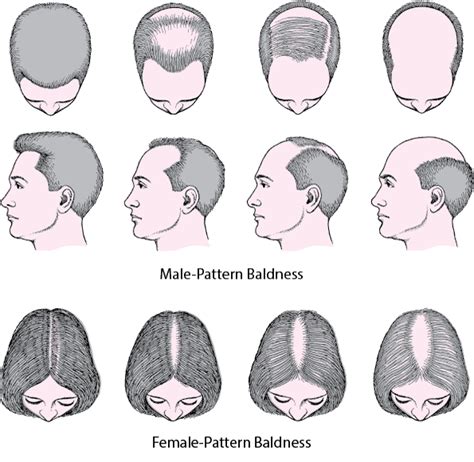Hair loss on top of the head, also known as vertex balding, is a common problem that affects both men and women. It can be caused by a variety of factors, including genetics, hormonal changes, and certain medical conditions.

Causes of Hair Loss on Top of Head
- Genetics: The most common cause of hair loss on top of the head is genetics. This type of hair loss is known as androgenetic alopecia, and it is caused by a combination of genes and hormones. Androgenetic alopecia is the most common type of hair loss in men, and it is also the most common cause of hair loss in women.
- Hormonal changes: Hair loss on top of the head can also be caused by hormonal changes. This type of hair loss is known as telogen effluvium, and it is caused by a temporary disruption in the hair growth cycle. Telogen effluvium can be caused by a variety of factors, including childbirth, menopause, and certain medical conditions.
- Medical conditions: Hair loss on top of the head can also be caused by certain medical conditions. These conditions include thyroid disease, lupus, and alopecia areata.
Treatments for Hair Loss on Top of Head
There are a variety of treatments available for hair loss on top of the head. The best treatment for you will depend on the cause of your hair loss.
- Medications: There are a number of medications available that can help to treat hair loss on top of the head. These medications include minoxidil and finasteride. Minoxidil is a topical medication that is applied to the scalp. It works by stimulating hair growth. Finasteride is an oral medication that is used to treat male pattern baldness. It works by blocking the production of dihydrotestosterone (DHT), which is a hormone that can cause hair loss.
- Surgery: Hair transplantation is a surgical procedure that can be used to treat hair loss on top of the head. During this procedure, hair follicles are removed from the back of the scalp and transplanted to the top of the head. Hair transplantation is a permanent solution for hair loss, but it can be expensive and time-consuming.
Prevention of Hair Loss on Top of Head
There are a number of things you can do to help prevent hair loss on top of the head. These include:
- Maintaining a healthy diet: Eating a healthy diet can help to keep your hair healthy and strong. Make sure to eat plenty of fruits, vegetables, and whole grains.
- Getting regular exercise: Regular exercise can help to improve blood circulation to the scalp. This can help to promote hair growth.
- Managing stress: Stress can contribute to hair loss. Find healthy ways to manage stress, such as exercise, yoga, or meditation.
- Avoiding harsh hair treatments: Harsh hair treatments, such as dyeing and bleaching, can damage hair and lead to hair loss. Limit the use of these treatments and use them sparingly.
Common Mistakes to Avoid
When it comes to hair loss on top of the head, there are a number of common mistakes to avoid. These include:
- Ignoring the problem: If you are experiencing hair loss on top of the head, it is important to see a doctor to determine the cause. Ignoring the problem will not make it go away, and it could lead to further hair loss.
- Trying to treat hair loss on your own: There are a number of over-the-counter hair loss treatments available, but they are not always effective. It is important to see a doctor before trying any hair loss treatments on your own.
- Giving up too soon: Hair loss treatment can take time to work. Do not get discouraged if you do not see results immediately. Be patient and stick with your treatment plan.
FAQs
-
What is the most common cause of hair loss on top of the head?
The most common cause of hair loss on top of the head is genetics. Androgenetic alopecia, also known as male pattern baldness, is a condition that affects both men and women. It is caused by a combination of genes and hormones. -
What are the symptoms of hair loss on top of the head?
The symptoms of hair loss on top of the head can vary depending on the cause of the hair loss. In general, hair loss on top of the head will appear as a thinning of the hair on the crown of the head. The hair may also become shorter and finer. -
How is hair loss on top of the head diagnosed?
Hair loss on top of the head is diagnosed by a physical examination of the scalp. Your doctor will also ask you about your medical history and your family history of hair loss. -
What are the treatments for hair loss on top of the head?
There are a number of treatments available for hair loss on top of the head. The best treatment for you will depend on the cause of your hair loss. Medications, surgery, and lifestyle changes are all options that may be considered. -
Can hair loss on top of the head be prevented?
There is no sure way to prevent hair loss on top of the head, but there are a number of things you can do to help reduce your risk. These include maintaining a healthy diet, getting regular exercise, managing stress, and avoiding harsh hair treatments. -
What are the emotional effects of hair loss on top of the head?
Hair loss on top of the head can have a significant impact on your emotional health. It can lead to feelings of shame, embarrassment, and low self-esteem. It is important to remember that you are not alone and that there are many people who have experienced hair loss. There are also a number of resources available to help you cope with the emotional effects of hair loss.
